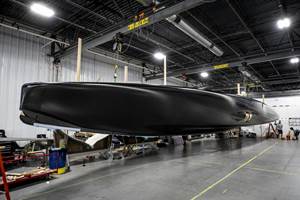Exel Composites and CNIM partner on glass fiber components for world's largest fusion facility
Fiberglass components to be used for the magnet support structure of the International Thermonuclear Experimental Reactor (ITER).
Global pultrusion company Exel Composites (Vantaa, Finland ) announced March 21 it is collaborating with French industrial contractor CNIM (Île-de-France, France) on the manufacture of fiberglass components for the magnet support structure of the International Thermonuclear Experimental Reactor (ITER), the world’s largest experimental fusion facility. To satisfy the stringent quality demands for the pre-compression rings, Exel Composites successfully solved the challenge of producing defect-free pultruded profiles of around 3 km in length.
The €18 billion ITER under construction in Saint-Paul-lez-Durance, France, is designed to demonstrate that fusion power can be produced on a commercial scale, providing a safe, environmentally sustainable energy source. The ITER will use hydrogen fusion, controlled by superconducting magnets, to produce massive heat energy. In the commercial machines that will follow, this heat will drive turbines to produce electricity.
The composite pre-compression rings are the cornerstone of the ITER’s magnet system support structure. They will ensure the operation of the toroidal field coils employed to create a magnetic 'cage' to confine the super-hot (150 million °C) plasma. To reduce fatigue and deformation of the coils resulting from the powerful magnetic fields, three pre-compression rings will be placed on top of them and three below. An extra set of three will be manufactured in case replacement becomes necessary in future. The pre-compression rings are required to withstand maximum hoop stresses of up to 500 MPa at room temperature. Glass fibre epoxy composite with a high fibre content was selected as the most suitable material to withstand such extreme loads, avoid circulation of electromagnetic currents and deliver a long service life. The composite rings will have a diameter of approximately 5 m, a cross-section of nearly 30 cm x 30 cm and will weigh slightly more than 3 tons.
Engineers at CNIM’s workshop in Toulon have been tasked with developing a manufacturing process for the spare pre-compression rings, and their subsequent production. The novel process relies on pultruded composite profiles produced by Exel Composites. Each ring will be produced by winding a 2 mm thick, 2.8 km long, flat pultruded profile around a metal tool. A 0.12 mm thick epoxy adhesive tape is wound over each layer. The completed ring lay-up is cured and then machined to the required final dimensions.
CNIM selected Exel Composites for this project based on the company’s proven capability in the manufacture products of superior quality for the most demanding applications. Exel formulated a high performance epoxy resin system to meet the mechanical specifications for the pre-compression rings and ensured that the 3 km profiles supplied were defect-free along their entire length by means of online non-destructive testing (NDT). The handling of this length of profile presented a further challenge, which Exel solved by winding the product on a customised bobbin for supply to CNIM.
CNIM has already manufactured a series of prototypes, which are currently undergoing NDT and qualification tests. Production of the full-scale pre-compression rings will begin later this year. “We are proud to support the ground-breaking ITER demonstrator as it prepares the way for the fusion power plants of tomorrow,” states Kari Loukola, Senior Vice President, Sales & Marketing, Exel Composites. “This represents a further example of Exel’s commitment to innovation and collaboration with our customers in the pursuit of new applications for composite materials.” The ITER facility itself is now 50% complete, with First Plasma (machine switch on) scheduled for 2025. ITER scientists predict that fusion plants could start to come on line as soon as 2040.
Related Content
Pro-Set named official materials supplier for New York Yacht Club American Magic
Competitive sailing team prepares for the 37th America’s Cup beginning in August 2024 with adhesives, resins and laminate testing services for its AC75 monohull construction.
Read MoreXlynX Materials BondLynx and PlastiLynx for low surface energy PP, PE substrates
Award-winning Xlynx materials use breakthrough “diazirine” technology to boost bond strength up to 950% as adhesives, primers and textile strengtheners.
Read MoreMaterials & Processes: Fabrication methods
There are numerous methods for fabricating composite components. Selection of a method for a particular part, therefore, will depend on the materials, the part design and end-use or application. Here's a guide to selection.
Read MoreThe making of carbon fiber
A look at the process by which precursor becomes carbon fiber through a careful (and mostly proprietary) manipulation of temperature and tension.
Read MoreRead Next
Composites end markets: Energy (2024)
Composites are used widely in oil/gas, wind and other renewable energy applications. Despite market challenges, growth potential and innovation for composites continue.
Read MoreCW’s 2024 Top Shops survey offers new approach to benchmarking
Respondents that complete the survey by April 30, 2024, have the chance to be recognized as an honoree.
Read MoreFrom the CW Archives: The tale of the thermoplastic cryotank
In 2006, guest columnist Bob Hartunian related the story of his efforts two decades prior, while at McDonnell Douglas, to develop a thermoplastic composite crytank for hydrogen storage. He learned a lot of lessons.
Read More

























